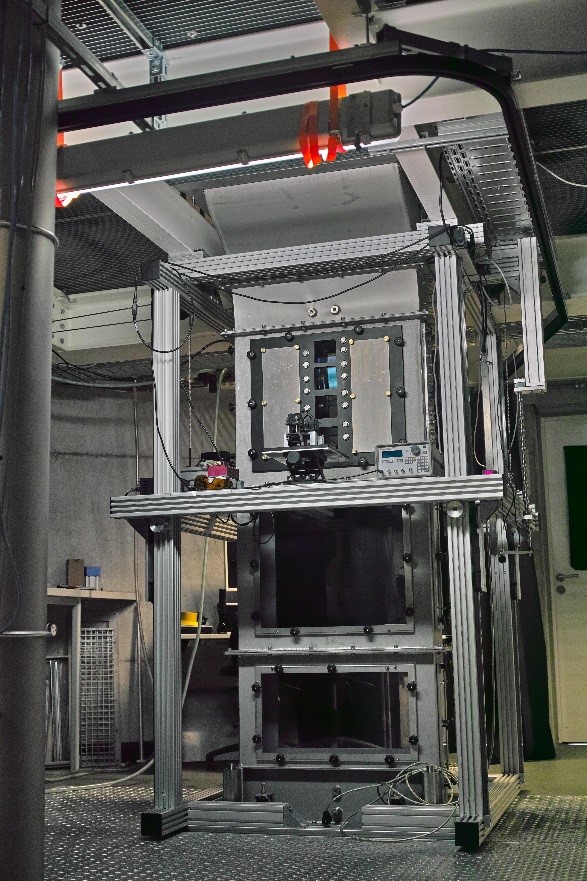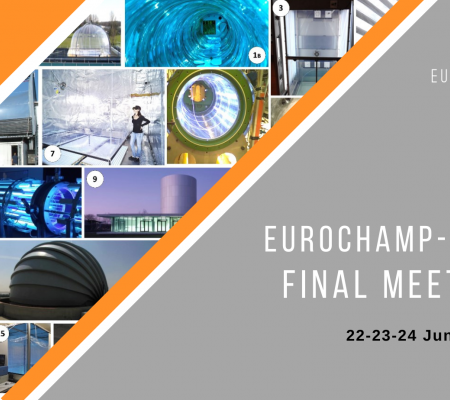| General information |
| Access mode |
Physical access |
| Infrastructure name and acronym |
Leipziger Aerosolkammer (LEAK) / Leipziger Aerosol and Cloud Interaction Simulator (LACIS) |
| Photos |
|
| Location |
51.35°N, 12.43°E, 120 m a.s.l.
Permoserstr. 15, D-04318 Leipzig, Germany |
| Website |
http://www.tropos.de/en/research/projects-infrastructures-technology/technology-at-tropos/aerosol-research-facilities/aerosol-chamber-experiments/
http://www.tropos.de/en/research/projects-infrastructures-technology/technology-at-tropos/aerosol-research-facilities/lacis/ |
| Legal name of organisation operating the infrastructure |
Leibniz-Institut für Troposphärenforschung e.V. (TROPOS) |
| Description of the infrastructure |
| Brief general description of the infrastructure to which access is offered |
The simulation chamber LEAK has a cylindrical geometry, a volume of 19 m3 and is made of Teflon FEP film. LEAK is equipped with a humidifier, ozone and particle generators. Fifty-six UV lamps (100W Eversun Super, Phillips) are used to illuminate the aerosol chamber. LEAK experiments are performed at humidities up to 80%, allowing the study of multiphase chemical processes with deliquescent particles.
Additionally, black-light and low–pressure mercury lamps are installed to produce continuously OH-radicals from HONO or H2O2. Outlets of the chamber are connected with a condensation particle counter (CPC), a continuous monitoring ozone analyzer and a particle sampling filter device with a fixed integrated annular denuder to avoid gaseous contamination of the deposited particles during sampling. Additionally, particle sampling can be performed by a condensational sampler (C-GIS) and two available particle-into-liquid samplers (PILS).
Since recently LEAK can be operated as a flow-through-reactor which has been proven useful for the study of HOMs / ELVOCs where LEAK belongs to the few chamber installations where these species are being investigated.
The size distributions of particles in the aerosol chamber as a function of time are measured by a differential mobility particle sizer (DMPS). An Agilent gas chromatograph (GC-MS) and a PTR-TOF-MS (Ionicon) monitor the gas-phase hydrocarbon concentrations in the chamber. Besides trace gas monitors, a variety of state-of-the-art instrumentation including a CI-APi-TOF (Airmodus, Ltd., Tofwerk AG) and a W-ToF Aerosol mass spectrometer (Aerodyne Inc) is available. For the analysis of particulate products highly sophisticated instrumentation, e.g. High-Performance Liquid Chromatography Electrospray Ionization coupled to Time-of-Flight Mass Spectrometry (HPLC/(-)ESI-TOFMS), Ultra-Performance Liquid Chromatography Electrospray Ionization coupled to Ion-Mobility Mass Spectrometer with a Time-of-Flight Mass Spectrometry (UPLC/ESI-IMS-QTOFMS) and High-Performance Anion-Exchange Chromatography with Pulsed Amperometric Detection (HPAEC-PAD) can be used. Complementary methods are capillary electrophoresis (CE) and CE-MS while auxiliary measurements include carbon sum parameters, ion chromatography and include IC and CE. Very advanced offline analytical capabilities are through cooperation with the UFZ on campus allowing FT-ICR-MS and nano-SIMS studies.
The Leipzig Biomass Burning Facility (LBBF) is part of LEAK. This facility allows studying not only the emissions from biomass burning but also the processing (aging) of the emitted smoke, i.e. to allow the investigation of gas phase products as well as SOA formation. LEAK and the Leipziger Aerosol and Cloud Interaction Simulator (LACIS) can interact to allow not only the study of chemical particle processes but also the measurement of important microphysical properties like cloud droplet and ice-formation depending on the chemical nature of the particles generated and characterised in LEAK.
Hence, in summary, LEAK offers:
- The ability to perform experiments at high relative humidities for aerosol multiphase process studies.
- Highly sophisticate analytical tools for offline particle organics analysis.
- The use of the LBBF for studies of biomass aerosol processing.
- The interaction with LACIS for the characterisation of the microphysical properties of the particles.
The Leipzig Aerosol and Cloud Interaction Simulator (LACIS) is a world-widely unique infrastructure for investigating aerosol-cloud- interaction processes under well-defined fluid- and thermodynamic conditions. E.g., LACIS has been very successfully, used for studying the hygroscopic growth and activation of aerosol particles. Currently the main focus at LACIS is on heterogeneous ice nucleation induced by lab-generated and natural aerosol particles. LACIS offers a variety of state-of-the-art and high-end peripheral instrumentation for generating and physically characterizing aerosol and ice particles, as well as cloud droplets. Computational fluid and particle / droplet dynamical models are available for determination of suitable experimental conditions and interpretation of experimental results.
LACIS is currently extended to allow for the investigation of cloud microphysical processes under turbulent flow conditions. Thereby we are opening up and offering new and unique research opportunities concerning the interactions between cloud microphysics and turbulence.
Specifically, LACIS offers:
- provision of well-defined and -characterized aerosol-particles
- opportunities to investigate cloud microphysical processes under well-defined thermodynamic, laminar or turbulent flow conditions. This includes both fundamental research at process level, and the intercomparison and evaluation of instrumentation.
|
| Services currently offered by the infrastructure and its research environment |
LEAK-LACIS has a more then 10-year history in providing access for guest researchers from all over the world. This comprises both, the scientific and logistical organisation of scientific activities in general and measurement campaigns, in particular. Efficient high-quality research is ensured through the existing excellent expertise in the experimental and theoretical investigation of gas-phase processes, SOA formation processes and the processing of biomass burning exhausts as well as aerosol and cloud microphysical processes. LEAK-LACIS is operated by a team of highly motivated, capable, and experienced PhD-, PostDoc-, and senior-level scientists which makes high quality scientific work and stimulating discussion a matter of course. Last but not least, TROPOS has year-long experience in the logistics of hosting guest scientists and organizing international transport of equipment.
|
| Modalities of access and support offered under EUROCHAMP-2020 |
| Typical duration of work |
A total of 110 access days is offered under EUROCHAMP-2020 at LEAK-LACIS including provision of peripheral instrumentation for chemical analysis, peripheral instrumentation for physical aerosol characterization and use of biomass burning facility. Most campaigns have a duration between 1 and 3 weeks. A typical work includes 2-3 days to carefully prepare the experiments, then 10 days of experiments (1 experiments/day), then 1-2 days for debriefing and base data formatting, saving, and distributing among the users.
|
| Community/user type served |
Users from the academic sector (expert as well as young researchers) make up the vast majority of the users.
|
| Scientific and technical support offered |
Both scientific and technical support is offered at LEAK-LACIS. |
| Logistic and administrative support offered |
Support concerning shipping, handling of instrumentation, travel and accommodation is offered at LEAK-LACIS. |
| Person in charge of access provision at the infrastructure |
LEAK: Prof. Dr. Hartmut Herrmann, Head of the Atmospheric Chemistry Department (ACD), herrmann[at]tropos.de
LACIS: Dr. Dennis Niedermeier, niederm[at]tropos.de |
| Extended technical description |
| Physical description |
The LEAK chamber is made of Teflon FEP 500A with a cylindrical geometry
Volume: 19 m3
Diameter: 3m
Height: 2.68 m
Surface-to-volume ratio : 2 m-1
temperature range: LEAK: 16-30°C; ACD-C: 10-40°C
Irradiation JNO2: 6.4x10-3 s-1
Pressure range: ambient
RH range: <5% to 80%
The LACIS is a turbulent humid-air wind-tunnel, i.e., a flow through chamber, made of stainless steel with a cubic geometry.
Length: 2.0 m
Width: 0.8 m
Depth: 0.2 m
Volume: 0.32 m3
Surface-to-volume ratio: 12.5 m-1
Flowrate: 10000 l/min
Temperature range: -40°C ... +25°C
Pressure range: measurements are performed in ambient pressure
RH range: ~1% - 100%~, supersaturation can be achieved through isobaric mixing of two saturated air-flows (up to 2% so far).
The measurement section of LACIS-T is a rectangular prism, 2.0 m long, 0.8 m wide and 0.2 m deep: the projected surface area is 0.80 m x 0.20 m = 0.16 m2 |
| Mechanical description |
LEAK 
LACIS 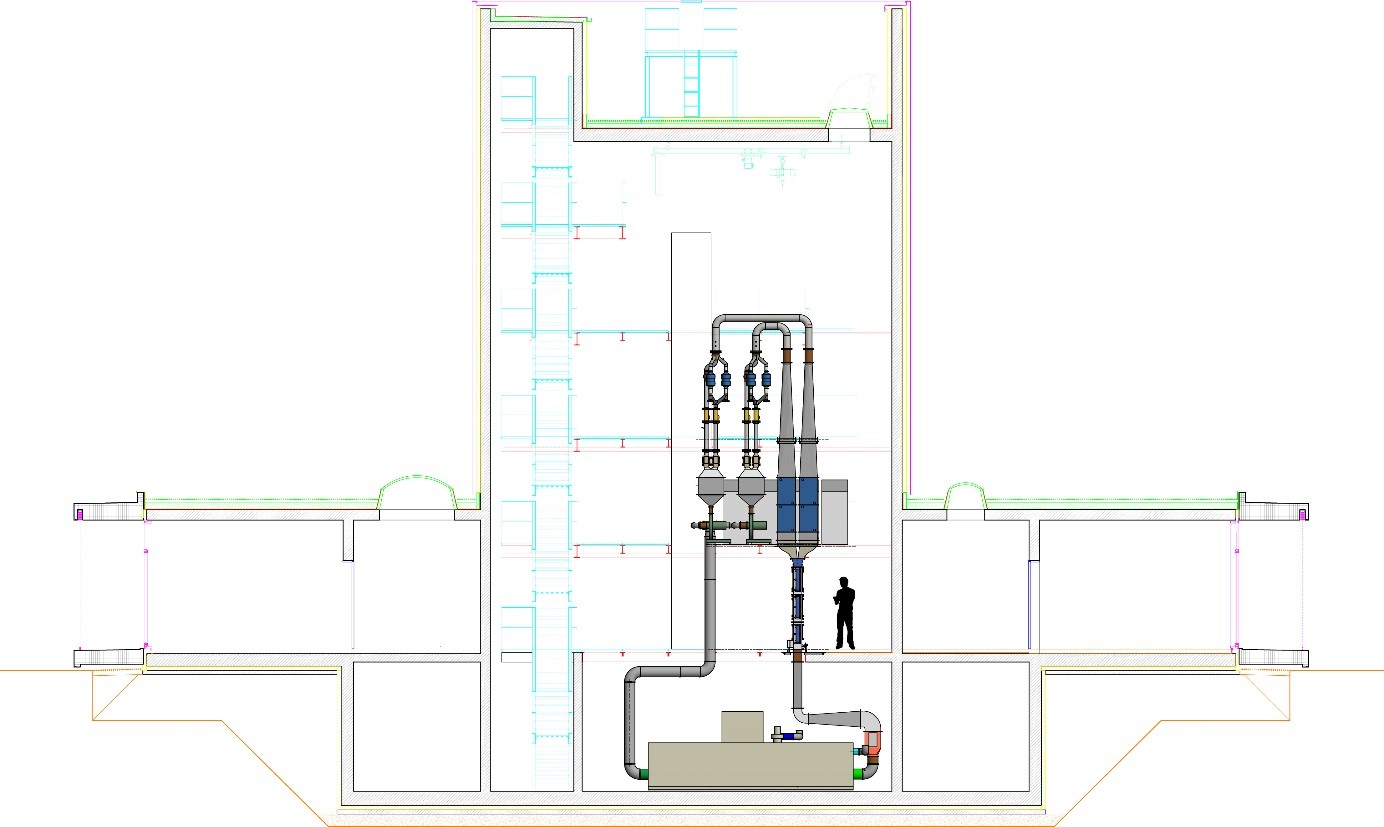
|
| Auxiliary mechanism |
LEAK
| Compound |
(k1st ± standard error) wall loss |
Comment |
| O3 |
(2.08±0.01) x 10-5 s-1 |
RH<1% |
| NO |
(4.59±1.80) x 10-7 s-1 |
RH<1% |
| NO2 |
(2.51±2.72) x 10-6 s-1
|
RH<1% |
| Benzene |
(3.77±1.62) x 10-7 s-1 |
RH<1% |
| m-Cresol |
(1.60±0.06) x 10-5 s-1 |
RH<1% |
| Limonene |
(7.92±5.99) x10-6 s-1 |
RH<1% |
| alpha-Pinene |
(1.87±0.01) x 10-5 s-1 |
RH50% |
| Hexenal |
(9.20±0.84) x 10-6 s-1 |
RH50% |
| Nopinone |
(1.20±0.01) x 10-5 s-1 |
RH50% |
LACIS
| Parameter |
Description |
Experiment |
| Particle dilution |
X + DIL → |
Direct measurement of particle concentration at the inlet
and in the measurement section of LACIS-T; comparison with calculations |
| Background particle concentration |
N < 1 cm-3 |
Determined in reference experiment |
| Turbulence decay (σ2w) |
σ2w = (z - zgrid)n with n = -1.4
zgrid… turbulence grid position
z… vertical position |
Determined in reference experiment |
| Turbulent mixing zone widening (σR) |
σR = σR(z)
R = T, qv, RH, or N |
Determined in reference experiment |
|
| Size dependent aerosol loss/lifetime (LEAK) |
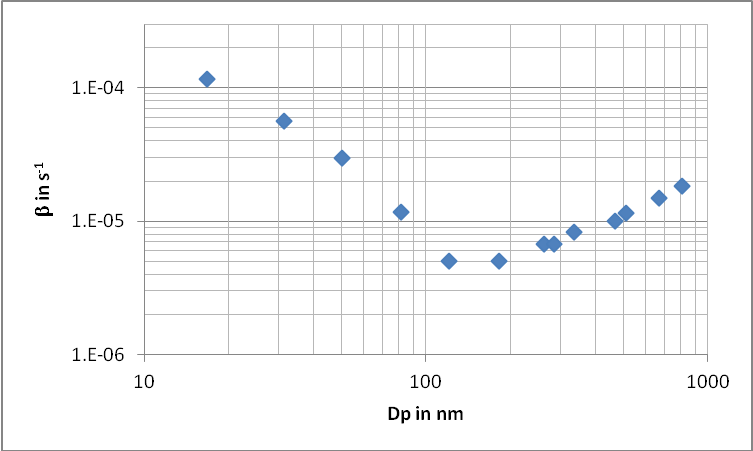 |
| Irradiation spectrum |
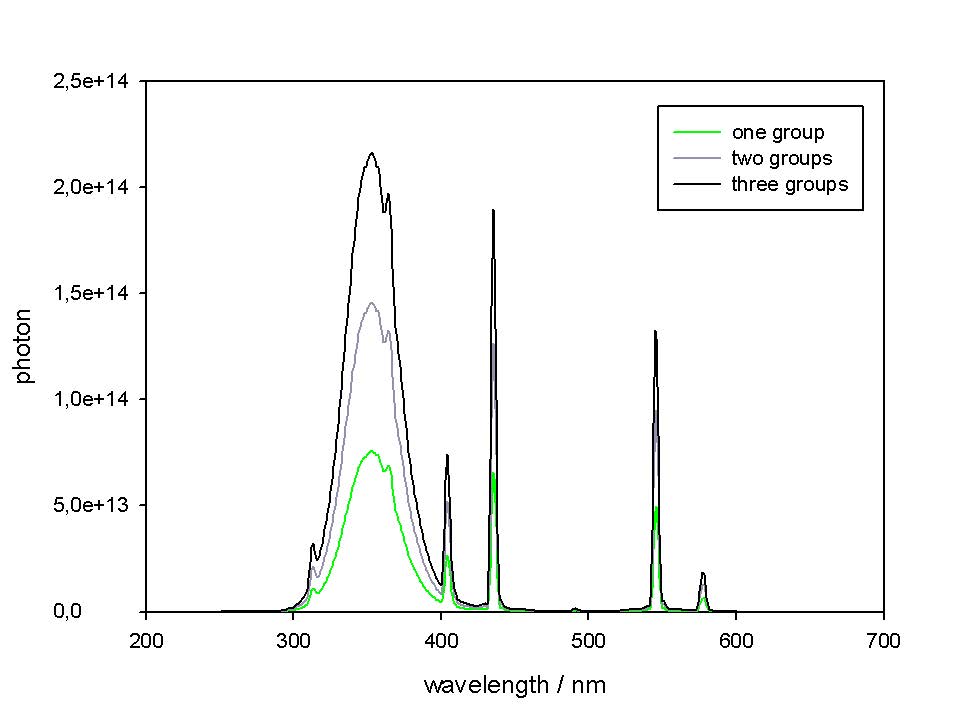 |
| Description paper |
LEAK:
Mothes et al to Mutzel, A., Poulain, L., Berndt, T., Iinuma, Y., Rodigast, M., Böge,O., Richters, S., Spindler, G., Sipilä, M., Jokinen, T., Kulmala,M., and Herrmann, H.: Highly Oxidized Multifunctional Organic Compounds Observed in Tropospheric Particles: A Fieldand Laboratory Study, Environ. Sci. Technol., 49, 7754-7761, https://doi.org/10.1021/acs.est.5b00885, 2015
LACIS:
Niedermeier, D., Voigtländer, J., Schmalfuß, S., Busch, D., Schumacher, J., Shaw, R. A., and Stratmann, F.: Characterization and first results from LACIS-T: A moist-air wind tunnel to study aerosol-cloud-turbulence interactions, Atmos. Meas. Tech. Discuss., https://doi.org/10.5194/amt-2019-343, in review, 2019. |

